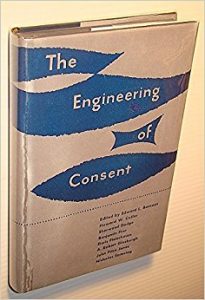The Engineering of Consent
Edward Bernays (1947)
“The Engineering of Consent” is an essay by Edward Bernays first published in 1947, and a book he published in 1955.
 In his own words, Bernays describes engineering consent as “use of an engineering approach—that is, action based only on thorough knowledge of the situation and on the application of scientific principles and tried practices to the task of getting people to support ideas and programs.”
In his own words, Bernays describes engineering consent as “use of an engineering approach—that is, action based only on thorough knowledge of the situation and on the application of scientific principles and tried practices to the task of getting people to support ideas and programs.”
Bernays explained, “Professionally, [public relations] activities are planned and executed by trained practitioners in accordance with scientific principles, based on the findings of social scientists. Their dispassionate approach and methods may be likened to those of the engineering professions which stem from the physical sciences.”
The essay appeared in the Annals of the American Academy of Political and Social Science. The author’s observations in the essay include the following:
- The United States has become a small room where a single whisper is magnified thousands of times.
- There are two divisions in media: commercial and organized group information systems.
- Today’s leaders have become more remote physically from the public, yet, at the same time, the public has much greater familiarity with these leaders through the system of modern communications…Increased influence of mass media is due to widespread and enormously rapid diffusion of literacy.
- With the aid of technicians in the field who have specialized in utilizing the channels of communications, [some leaders] have been able to achieve purposefully and scientifically what we have termed “the engineering of consent”.
- The freedoms of press, speech, petition and assembly, the freedoms which make the engineering of consent possible, are among the most cherished guarantees in the Constitution of the United States.
- Under no circumstances should the engineering of consent supersede or displace the educational system, either formal or informal, in bringing about understanding by the people as the basis for their actions. The engineering of consent often does supplement the educational process.
- The chief function [of the profession] is to analyze objectively and realistically the position of its client vis-a-vis a public, and to advise as to the necessary corrections in its client’s attitudes towards and approaches to that public.
- It must be remembered of course that good will, the basis of lasting adjustment, can be preserved in the long run, only by those whose actions warrant it…The public relations counsel has the professional responsibility to push only those ideas that he can respect, and not to promote causes or accept assignments for clients he considers anti-social.
- As in physical engineering, a feasibility study must be done and a budget drawn up.
- The engineer of consent must be powerfully equipped with facts, with truths, with evidence before he shows himself before a public.
- The public’s attitudes, ideas, presumptions or prejudices result from definite influences. One must try to find out what they are in any situation in which one is working.
- Democratic society is actually only a loose aggregate of constituent groups…To influence the public, the engineer of consent works with and through group leaders and opinion moulders on every level.
- Themes must appeal to the motives of the public. Motives are the activation of both conscious and subconscious pressure created by the force of desires
- Organization also correlates the activities of any specialists who may be called upon from time to time, such as opinion researchers, fund raisers, publicity men, radio and motion picture experts, specialists for women’s clubs or foreign language groups, and the like.
- Set in motion a broad activity, the success of which depends on interlocking all phases and elements of the proposed strategy, implemented by tactics that are timed to the moment of maximum effectiveness.
- The developing of events and circumstances that are not routine is one of the basic functions of the engineer of consent.
